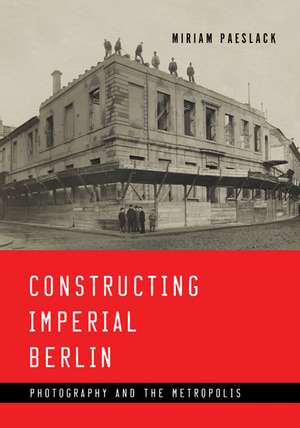Constructing Imperial Berlin: Photography and the Metropolis
Autor Miriam Paeslacken Limba Engleză Paperback – 15 ian 2019
How photography and a modernizing Berlin informed an urban image—and one another—in the late nineteenth and early twentieth centuries
Since the fall of the Berlin Wall, the city that once visually epitomized a divided Europe has thrived in the international spotlight as an image of reunified statehood and urbanity. Yet research on Berlin’s past has focused on the interwar years of the Weimar Republic or the Cold War era, with much less attention to the crucial Imperial years between 1871 and 1918.
Constructing Imperial Berlin is the first book to critically assess, contextualize, and frame urban and architectural photographs of that era. Berlin, as it was pronounced Germany’s capital in 1871, was fraught with questions that had previously beset Paris and London. How was urban expansion and transformation to be absorbed? What was the city’s understanding of its comparably short history? Given this short history, how did it embody the idea of a capital? A key theme of this book is the close interrelation of the city’s rapid physical metamorphosis with repercussions on promotional and critical narratives, the emergence of groundbreaking photographic technologies, and novel forms of mass distribution.
Providing a rare analysis of this significant formative era, Miriam Paeslack shows a city far more complex than the common clichés as a historical and aspiring place suggest. Imperial Berlin emerges as a modern metropolis, only half-heartedly inhibited by urban preservationist concerns and rather more akin to North American cities in their bold industrialization and competing urban expansions than to European counterparts.
Since the fall of the Berlin Wall, the city that once visually epitomized a divided Europe has thrived in the international spotlight as an image of reunified statehood and urbanity. Yet research on Berlin’s past has focused on the interwar years of the Weimar Republic or the Cold War era, with much less attention to the crucial Imperial years between 1871 and 1918.
Constructing Imperial Berlin is the first book to critically assess, contextualize, and frame urban and architectural photographs of that era. Berlin, as it was pronounced Germany’s capital in 1871, was fraught with questions that had previously beset Paris and London. How was urban expansion and transformation to be absorbed? What was the city’s understanding of its comparably short history? Given this short history, how did it embody the idea of a capital? A key theme of this book is the close interrelation of the city’s rapid physical metamorphosis with repercussions on promotional and critical narratives, the emergence of groundbreaking photographic technologies, and novel forms of mass distribution.
Providing a rare analysis of this significant formative era, Miriam Paeslack shows a city far more complex than the common clichés as a historical and aspiring place suggest. Imperial Berlin emerges as a modern metropolis, only half-heartedly inhibited by urban preservationist concerns and rather more akin to North American cities in their bold industrialization and competing urban expansions than to European counterparts.
Preț: 218.40 lei
Nou
Puncte Express: 328
Preț estimativ în valută:
41.80€ • 43.48$ • 35.03£
41.80€ • 43.48$ • 35.03£
Carte disponibilă
Livrare economică 21 februarie-07 martie
Livrare express 06-12 februarie pentru 41.09 lei
Preluare comenzi: 021 569.72.76
Specificații
ISBN-13: 9781517902957
ISBN-10: 1517902959
Pagini: 232
Ilustrații: 114
Dimensiuni: 178 x 254 x 15 mm
Greutate: 0.71 kg
Ediția:1
Editura: University of Minnesota Press
Colecția Univ Of Minnesota Press
ISBN-10: 1517902959
Pagini: 232
Ilustrații: 114
Dimensiuni: 178 x 254 x 15 mm
Greutate: 0.71 kg
Ediția:1
Editura: University of Minnesota Press
Colecția Univ Of Minnesota Press
Notă biografică
Miriam Paeslack is associate professor of modern and contemporary visual culture and arts management at the University at Buffalo. She is author of Berlin im 19. Jahrhundert: Frühe Photographien 1850–1914, coauthor of Johanna Diehl – Displace, and editor of Ineffably Urban: Imaging Buffalo.
Cuprins
Contents
Introduction
1. Crafting the Metropolis: Photo-Panoramas in the Illustrated Journal Berliner Leben
2. Framing Progress: Ludwig Hoffmann, Ernst von Brauchitsch, and Berlin Architectural Photography 1902–1912
3. Tracing Transformation: Berlin’s Urban Palimpsest in Photogrammetry and “Rubble Photography”
4. Inventing Tradition: Berlin’s Märkische Museum and Its Photo Survey Picturesque Berlin
Conclusion
Acknowledgments
Notes
Index
Introduction
1. Crafting the Metropolis: Photo-Panoramas in the Illustrated Journal Berliner Leben
2. Framing Progress: Ludwig Hoffmann, Ernst von Brauchitsch, and Berlin Architectural Photography 1902–1912
3. Tracing Transformation: Berlin’s Urban Palimpsest in Photogrammetry and “Rubble Photography”
4. Inventing Tradition: Berlin’s Märkische Museum and Its Photo Survey Picturesque Berlin
Conclusion
Acknowledgments
Notes
Index
Recenzii
"A late starter among European capitals, Imperial Berlin was eager to be recognized as a Weltstadt (‘World City’). Miriam Paeslack has carefully analyzed a trove of rarely seen images that perfectly document the city’s feverish development at the end of the nineteenth century and the parallel evolution of its self-conscious imagery. Taken together, the photographs present a compelling psychogram of the city on its way to becoming the 'Capital of the Twentieth Century'—the place where the dramatic tides of modernity and its traumatic conflicts would leave their most visible scars."—Dietrich Neumann, Brown University
"Miriam Paeslack has written a compelling account of the multifarious ways in which photographers mediated in the construction of Berlin’s urban imaginary. She brilliantly demonstrates photography’s potency as Berlin contended with modernity by simultaneously promoting progress and inventing the past."—Nancy Stieber, University of Massachusetts, Boston
"Miriam Paeslack has written a compelling account of the multifarious ways in which photographers mediated in the construction of Berlin’s urban imaginary. She brilliantly demonstrates photography’s potency as Berlin contended with modernity by simultaneously promoting progress and inventing the past."—Nancy Stieber, University of Massachusetts, Boston
